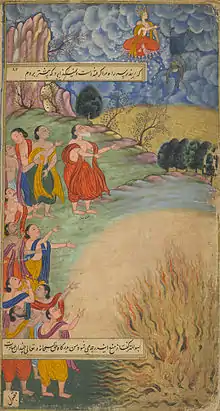Trishanku
Trishanku (त्रिशंकु) is a king in Hindu religion who belonged to Ishvaku descendancy. Trishanku is commonly referred to through mention of "Trishanku's heaven". The word Trishanku has come to denote a middle ground or limbo between one's goals or desires and one's current state or possessions.

Etymology
In Indian astronomy, Trishanku corresponds to the collection of three crosses around Southern Cross constellation.[1] The name Triśaṅku is a combination of Sanskrit words Tri meaning 'three' and śaṅku(शङ्कु) meaning 'stumps', thus the name mean 'Three stumps', likely denoting to the alignment of stars of the Southern cross constellation.
Story
The story of Trishanku is told in the Bala Kanda portion of the Valmiki Ramayana.
Born Satyavrata to King Prithu in the Solar Dynasty, he was an ancestor of Lord Rama. As he grew old, Satyavrata crowned his son Harishchandra whom he seated on the throne of Ayodhya, renouncing his royalty. Since he had lived a righteous life, Satyavrata's soul deserved ascension to the heavens, but he wished to do so with his mortal body and requested his Guru Vasishta to perform the needful rites to achieve this goal. Vasishta refused to perform the rituals and advised the former king that his wish is against the laws of nature and a mortal being may not enter the heavens with his physical body. Satyavrata was adamant and upon this refusal, approached Vasishta's eldest son Shakti to help him, attempting to lure the young sage with promises of wealth and fame. Satyavrata's attempt to position Shakti as his father's rival for a task previously refused by the sage, angered the son of Vasishta and he cursed Satyavrata, turning him into Trishanku, leaving him with a horrific form and debilitating afflictions. Trishanku was forced to leave his country and wander the wilderness.
During his wanderings, Trishanku met sage Vishwamitra and appealed to him for succor. Upon hearing the plight of the king, Vishwamithra, who had an intense rivalry of Vasishta, accepted Trishanku's request and agreed to perform the necessary rites to raise Trishanku to the heavens with his physical body.
The yagnas (rituals) began and with the ascetic powers of the sage, the former King Trishanku started ascending to heaven. Upon his arrival in heaven, the Devas were alarmed by this unnatural occurrence. Led by Indra, they refused to permit Trishanku to enter, and tossed him out. Trishanku began falling back to earth.
The furious Vishwamitra would not accept defeat at the hands of Indra. The sage used his powers to arrest Trishanku's fall, causing the latter to be suspended mid-air upside-down.
Trishanku begged Vishwamitra for help and the sage once again used his powers, this time beginning the creation of a parallel heaven in a portion of the southern sky. As the new heaven was built, the sage raised Trishanku to it and restored him to his former state before being cursed. Vishwamitra then began establishing Trishanku as the Indra of the new heaven that he had created. This alarmed the Devas who then appeared before the sage and tried to console him and withdraw him from his act. They explained to Vishwamithra that they only wished to prevent the unnatural act of someone entering heaven with his mortal body.
Vishwamitra was gradually convinced but now he faced the dilemma of having to break his own word that he gave to Trishanku about sending him to heaven. Vishwamitra reached a compromise with the Devas to let the King inhabit the new heaven that was created for him. The new heaven shall be called Trishanku's heaven and the king shall reside in this heaven from now on. He shall not supersede the command of Indra by ruling his own heaven, and to ensure that, the king shall reside upside down in his heaven.
Thus is the story of Trishanku who is suspended in his own heaven as a compromise between earth that he belonged to and the heaven that he sought.
The phrase "Trishanku's heaven" is used widely in India to describe similar situations faced in life. The story of Trishanku, Vaivasvata Manu and Yama have many similarities.
He was succeeded by his son Traishankavana (Harischandra)
See also
References
- "Crux - Trishanku". Space Yuga. 10 Feb 2010. Archived from the original on 30 January 2012. Retrieved 15 June 2011.